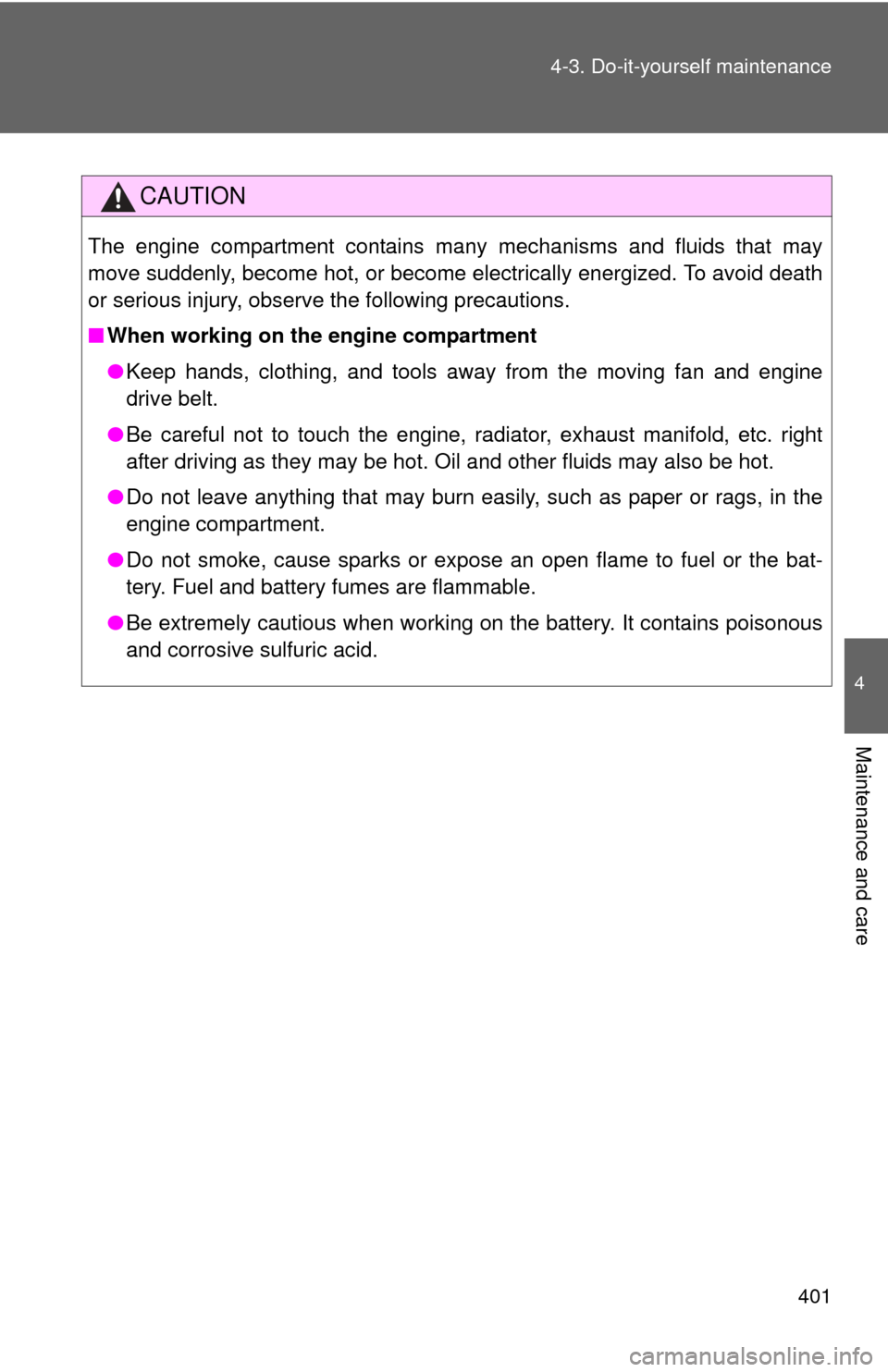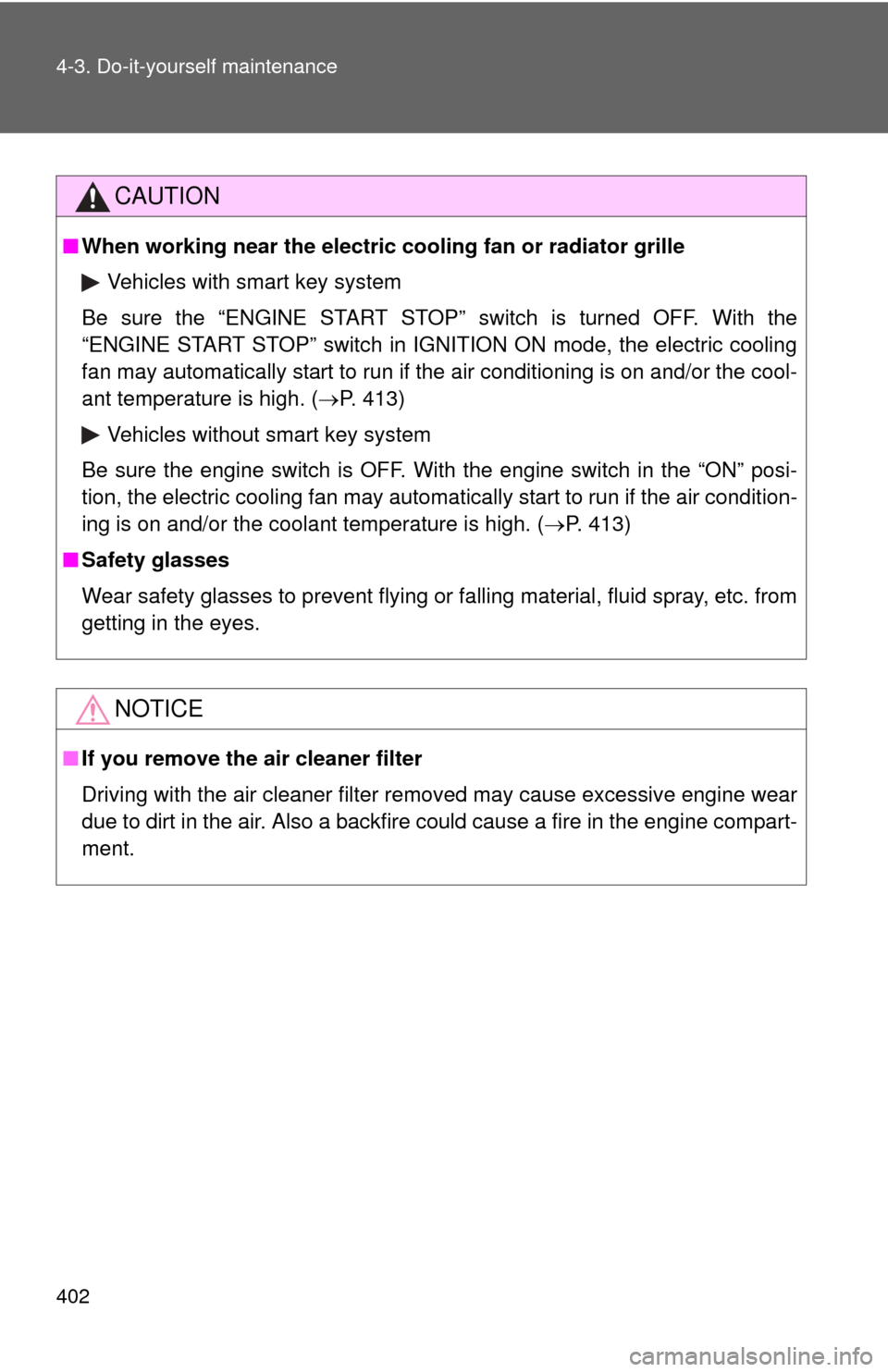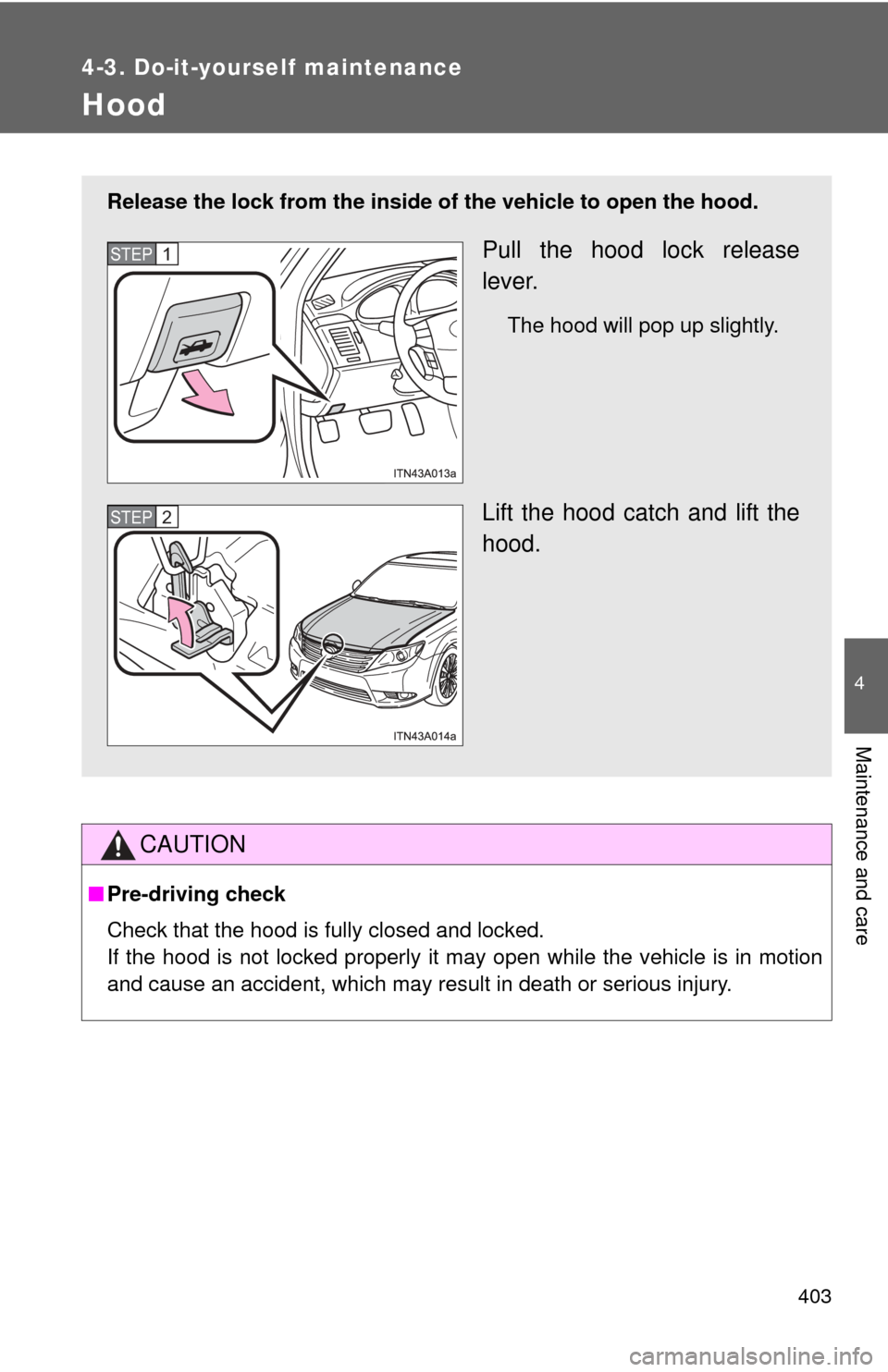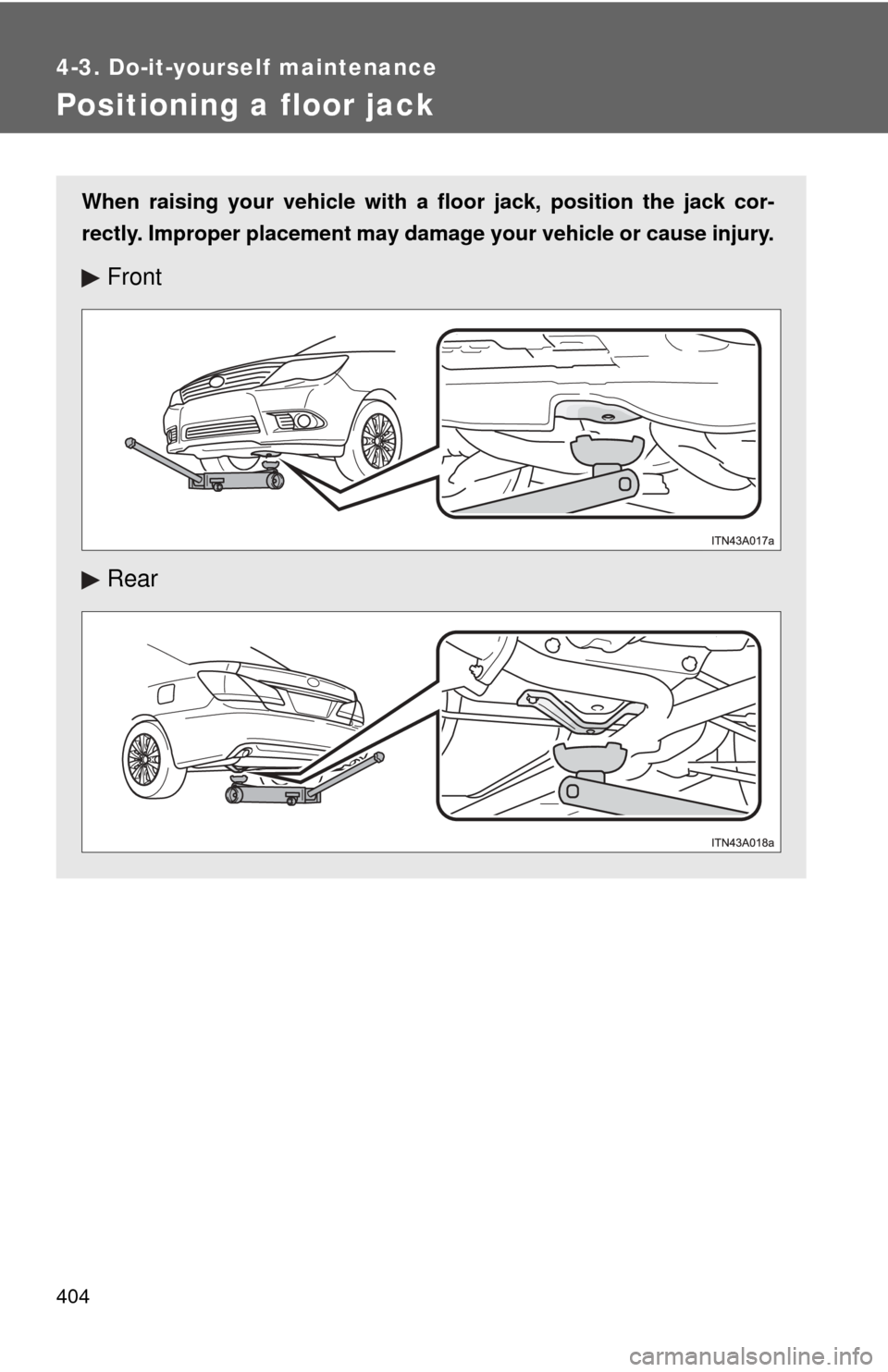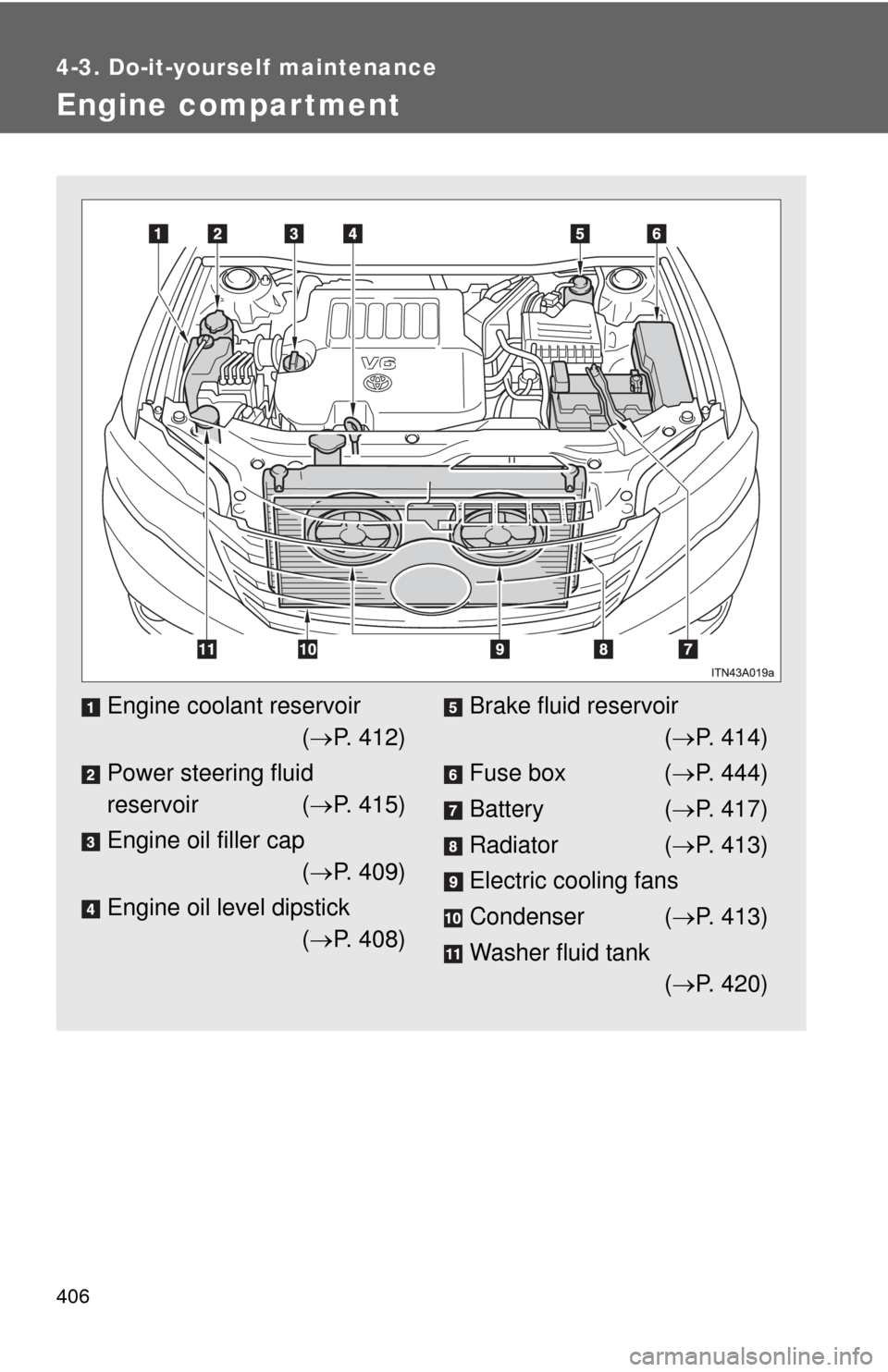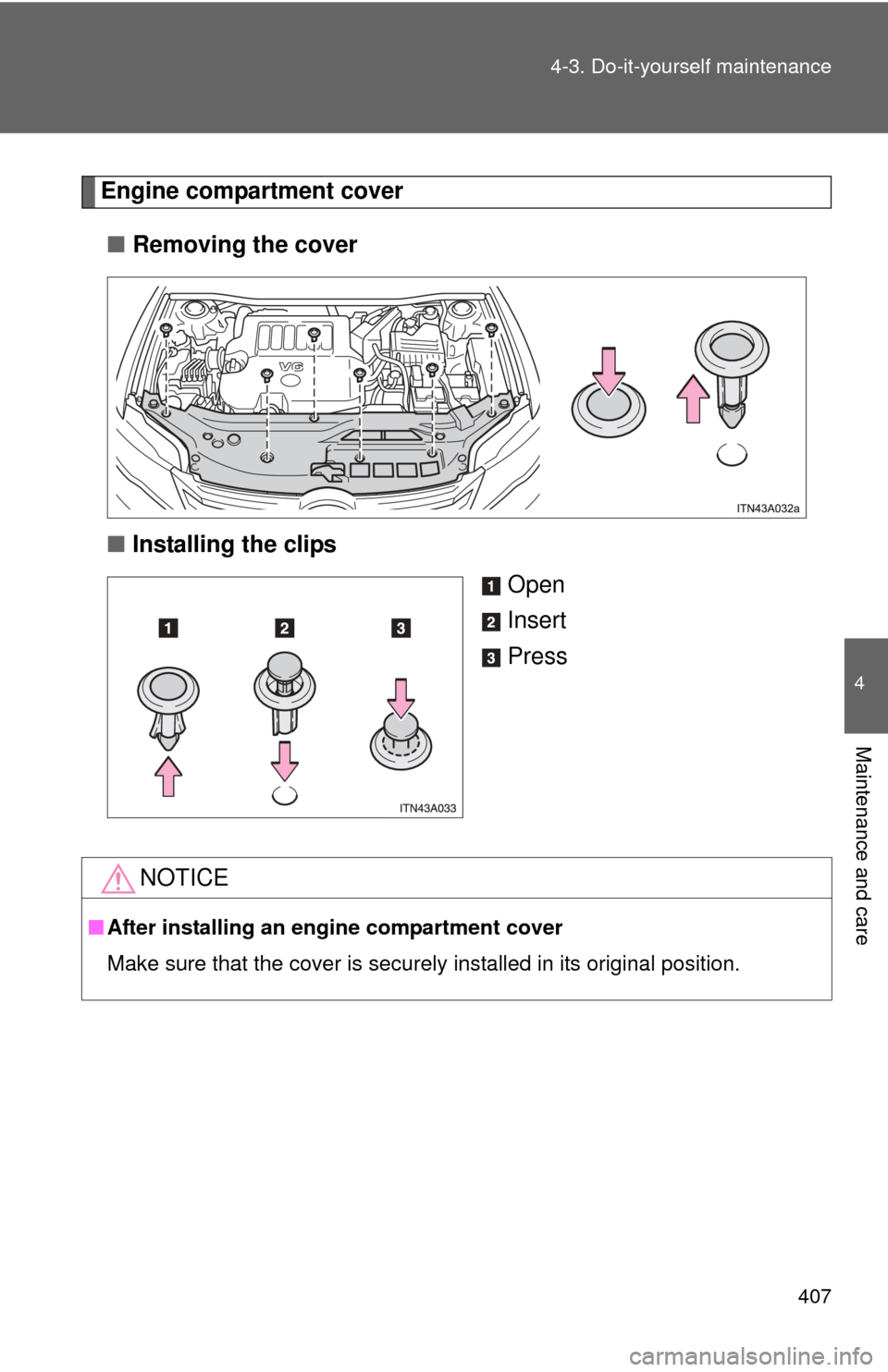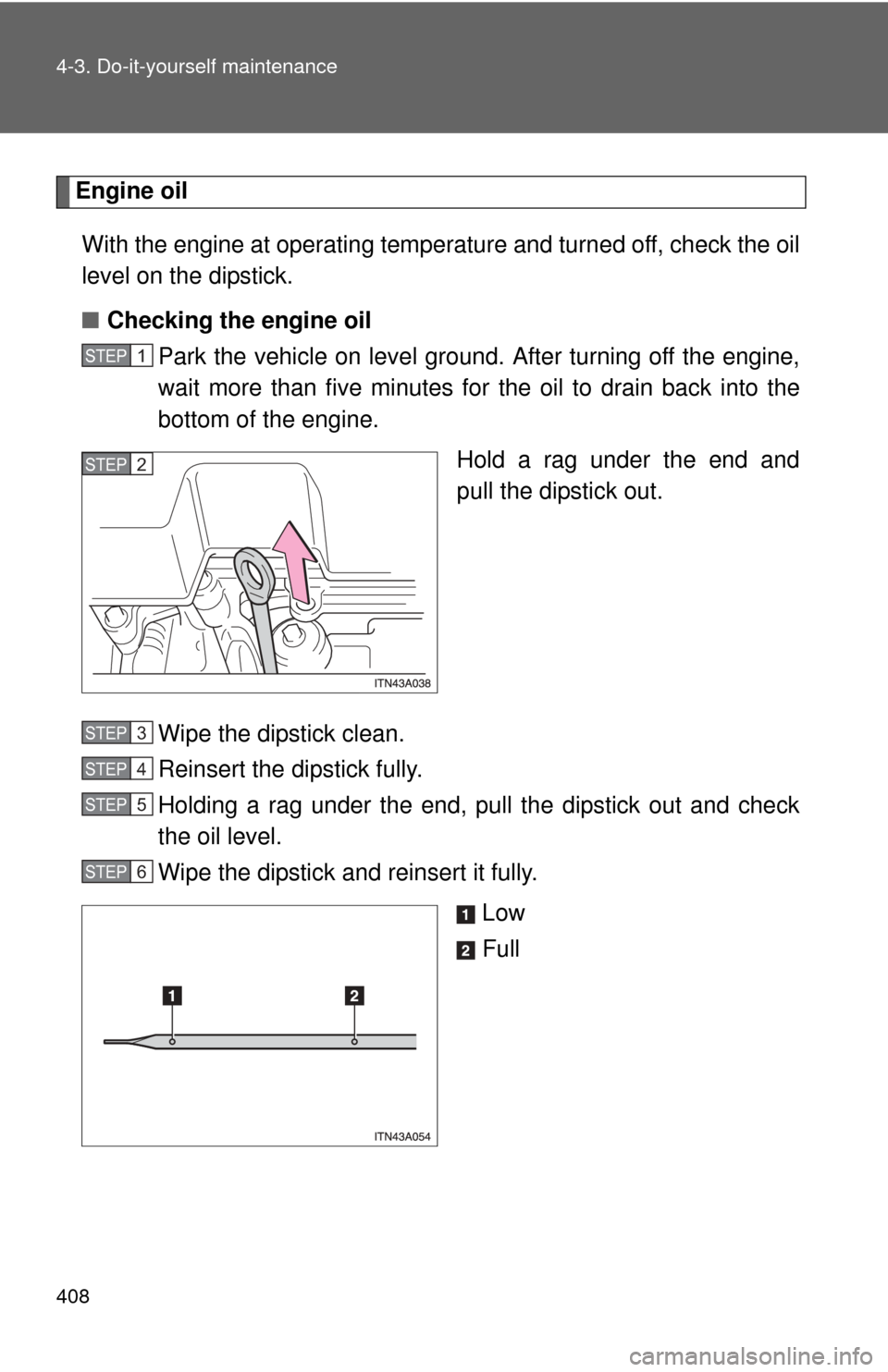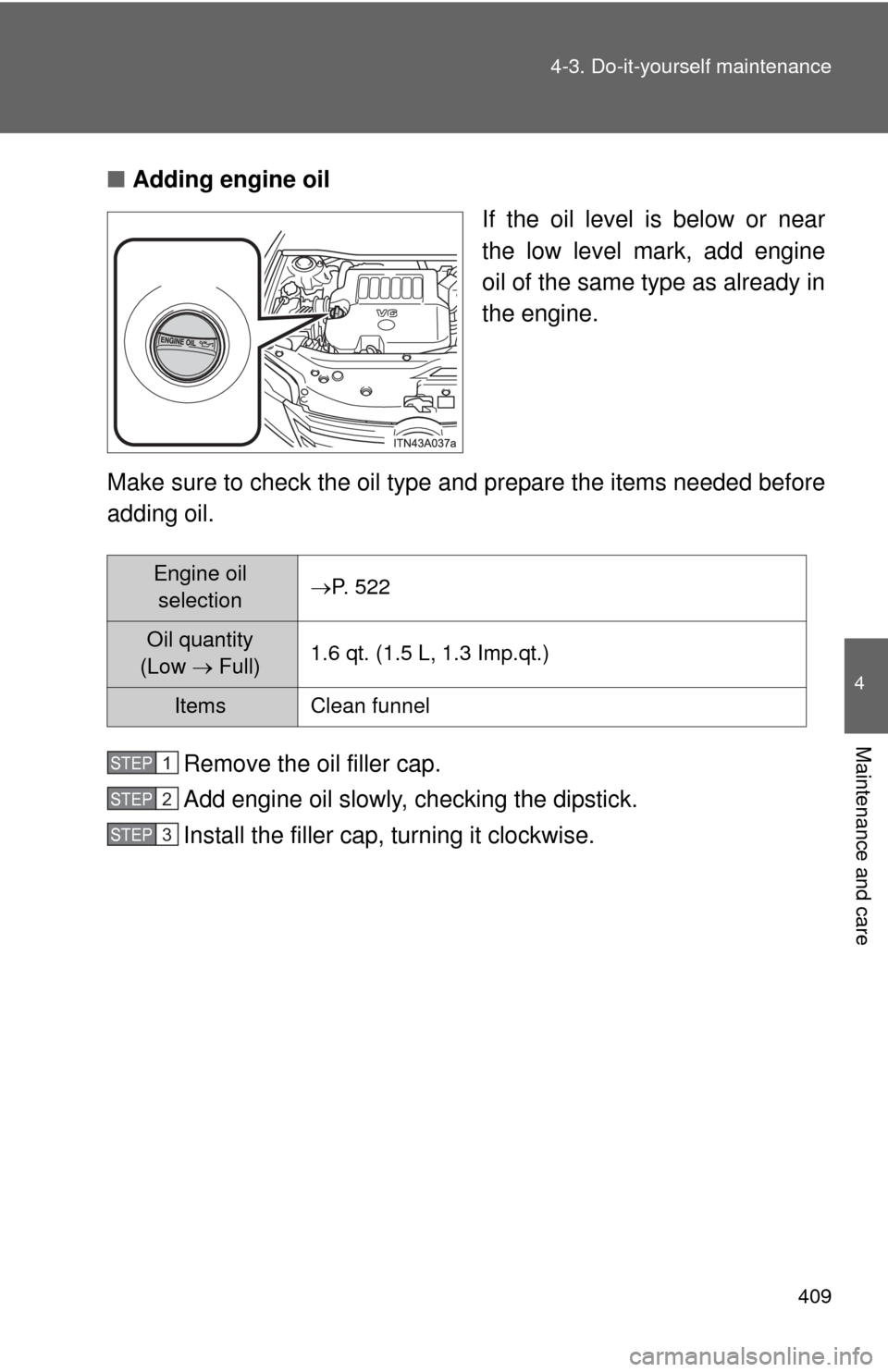TOYOTA AVALON 2012 XX40 / 4.G Owners Manual
AVALON 2012 XX40 / 4.G
TOYOTA
TOYOTA
https://www.carmanualsonline.info/img/14/6170/w960_6170-0.png
TOYOTA AVALON 2012 XX40 / 4.G Owners Manual
Trending: glove box, brake light, engine oil, service indicator, set clock, fuse box, deactivate passenger airbag
Page 401 of 580
4
Maintenance and care
401
4-3. Do-it-yourself maintenance
CAUTION
The engine compartment contains many mechanisms and fluids that may
move suddenly, become hot, or become electrically energized. To avoid death
or serious injury, observe the following precautions.
■
When working on the engine compartment
●Keep hands, clothing, and tools away from the moving fan and engine
drive belt.
● Be careful not to touch the engine, radiator, exhaust manifold, etc. right
after driving as they may be hot. Oil and other fluids may also be hot.
● Do not leave anything that may burn easily, such as paper or rags, in the
engine compartment.
● Do not smoke, cause sparks or expose an open flame to fuel or the bat-
tery. Fuel and battery fumes are flammable.
● Be extremely cautious when working on the battery. It contains poisonous
and corrosive sulfuric acid.
Page 402 of 580
402 4-3. Do-it-yourself maintenance
CAUTION
■When working near the electric cooling fan or radiator grille
Vehicles with smart key system
Be sure the “ENGINE START STOP” switch is turned OFF. With the
“ENGINE START STOP” switch in IGNITION ON mode, the electric cooling
fan may automatically start to run if the air conditioning is on and/or the cool-
ant temperature is high. ( P. 413)
Vehicles without smart key system
Be sure the engine switch is OFF. With the engine switch in the “ON” posi-
tion, the electric cooling fan may automatically start to run if the air condition-
ing is on and/or the coolant temperature is high. ( P. 413)
■ Safety glasses
Wear safety glasses to prevent flying or falling material, fluid spray, etc. from
getting in the eyes.
NOTICE
■If you remove the air cleaner filter
Driving with the air cleaner filter removed may cause excessive engine wear
due to dirt in the air. Also a backfire could cause a fire in the engine compart-
ment.
Page 403 of 580
403
4-3. Do-it-yourself maintenance
4
Maintenance and care
Hood
CAUTION
■Pre-driving check
Check that the hood is fully closed and locked.
If the hood is not locked properly it may open while the vehicle is in motion
and cause an accident, which may result in death or serious injury.
Release the lock from the inside of the vehicle to open the hood.
Pull the hood lock release
lever.
The hood will pop up slightly.
Lift the hood catch and lift the
hood.
STEP1
STEP2
Page 404 of 580
404
4-3. Do-it-yourself maintenance
Positioning a floor jack
When raising your vehicle with a floor jack, position the jack cor-
rectly. Improper placement may damage your vehicle or cause injury.
Front
Rear
Page 405 of 580
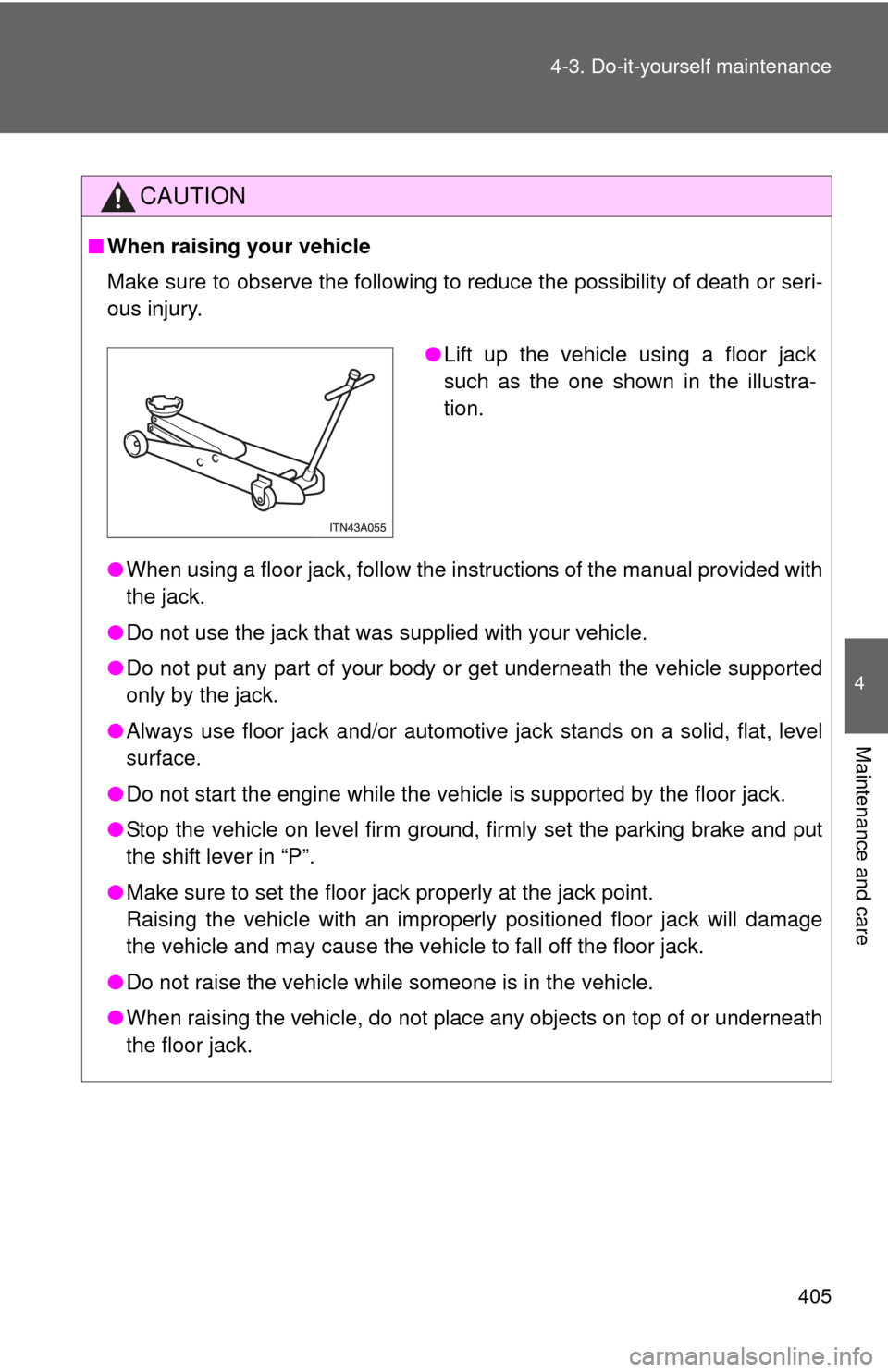
4
Maintenance and care
405
4-3. Do-it-yourself maintenance
CAUTION
■
When raising your vehicle
Make sure to observe the following to reduce the possibility of death or\
seri-
ous injury.
●When using a floor jack, follow the instructions of the manual provided with
the jack.
● Do not use the jack that was supplied with your vehicle.
● Do not put any part of your body or get underneath the vehicle supported
only by the jack.
● Always use floor jack and/or automotive jack stands on a solid, flat, level
surface.
● Do not start the engine while the vehicle is supported by the floor jack.
● Stop the vehicle on level firm ground, firmly set the parking brake and put
the shift lever in “P”.
● Make sure to set the floor jack properly at the jack point.
Raising the vehicle with an improperly positioned floor jack will damage
the vehicle and may cause the vehicle to fall off the floor jack.
● Do not raise the vehicle while someone is in the vehicle.
● When raising the vehicle, do not place any objects on top of or underneath
the floor jack.
●Lift up the vehicle using a floor jack
such as the one shown in the illustra-
tion.
Page 406 of 580
406
4-3. Do-it-yourself maintenance
Engine compar tment
Engine coolant reservoir( P. 412)
Power steering fluid
reservoir ( P. 415)
Engine oil filler cap ( P. 409)
Engine oil level dipstick ( P. 408)Brake fluid reservoir
( P. 414)
Fuse box ( P. 444)
Battery ( P. 417)
Radiator ( P. 413)
Electric cooling fans
Condenser ( P. 413)
Washer fluid tank ( P. 420)
Page 407 of 580
4
Maintenance and care
407
4-3. Do-it-yourself maintenance
Engine compartment cover
■ Removing the cover
■ Installing the clips
Open
Insert
Press
NOTICE
■After installing an engine compartment cover
Make sure that the cover is securely installed in its original position.
Page 408 of 580
408 4-3. Do-it-yourself maintenance
Engine oilWith the engine at operating temperature and turned off, check the oil
level on the dipstick.
■ Checking the engine oil
Park the vehicle on level gro und. After turning off the engine,
wait more than five minutes for the oil to drain back into the
bottom of the engine.
Hold a rag under the end and
pull the dipstick out.
Wipe the dipstick clean.
Reinsert the dipstick fully.
Holding a rag under the end, pull the dipstick out and check
the oil level.
Wipe the dipstick and reinsert it fully. Low
Full
STEP1
STEP2
STEP3
STEP4
STEP5
STEP6
Page 409 of 580
4
Maintenance and care
409
4-3. Do-it-yourself maintenance
■
Adding engine oil
If the oil level is below or near
the low level mark, add engine
oil of the same type as already in
the engine.
Make sure to check the oil type and prepare the items needed before
adding oil.
Remove the oil filler cap.
Add engine oil slowly, checking the dipstick.
Install the filler cap, turning it clockwise.
Engine oil selectionP. 522
Oil quantity
(Low Full) 1.6 qt. (1.5 L, 1.3 Imp.qt.)
Items Clean funnel
STEP1
STEP2
STEP3
Page 410 of 580
410 4-3. Do-it-yourself maintenance
■Engine oil consumption
●The amount of engine oil consumed depends on the oil viscosity, the
quality of the oil and the way the vehicle is driven.
● More oil is consumed under driving conditions such as high speeds, fre-
quent acceleration and deceleration.
● A new engine consumes more oil.
● When judging the amount of oil consumption, keep in mind that the oil
may have become diluted, making it difficult to judge the true level accu-
rately.
● Oil consumption: Max. 1.1 qt./600 miles, 0.9 lmp.qt./600 miles (1.0 L per
1000 km). If the vehicle consumes more than this amount, contact your
Toyota dealer.
Trending: remove seats, horn, dashboard, trailer, windshield wipers, seat adjustment, parking brake
